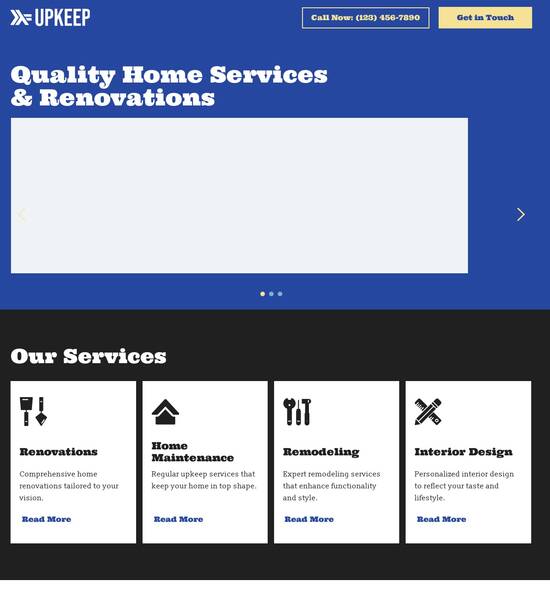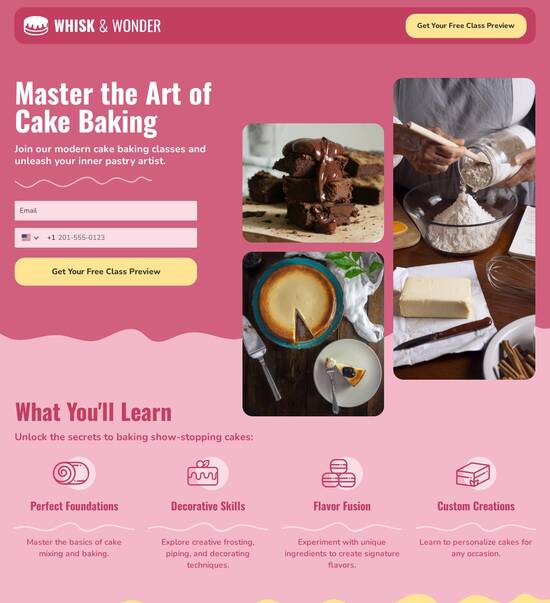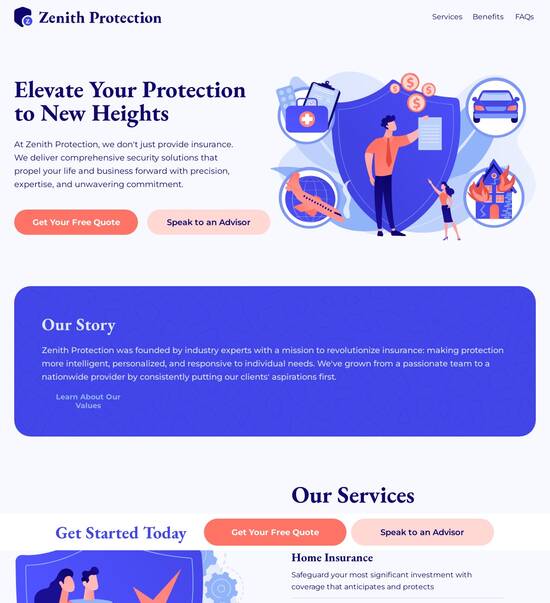
High performance shopping cart page template
Explore Similar TemplatesAbout template
Unleash your creativity with the high performance shopping cart page template. Try Instapage today.
Recommended templates

Easy to build without coding
With the intuitive drag-and-drop builder, anyone on your team can create high-converting pages without any knowledge of code or design. Make enhancements to your landing page with custom widgets using Javascript, HTML/CSS, or third-party scripts.

Multiple layouts for any industry and goal
Select from 500+ landing page layouts built to boost conversions across industry-specific scenarios. Customize them by adjusting fonts, adding images, and generating on-brand content with the AI assistant. Quickly scale with Instablocks® and Global Blocks that you can save, reuse, and update globally.

Loads fast and looks polished on any device
Every template is responsive, which means they present professionally on any device and load blazingly fast with our Thor Render Engine. You can also power them up with Google AMP technology to deliver an unparalleled mobile experience and drive higher conversions.

Robust analytics & experimentation
Get real-time updates and reporting across all your devices, showing the number of visitors, conversions, cost-per-visitor, and cost-per-lead. Launch AI-powered experiments, run A/B tests, and use heatmaps to analyze user behavior, then optimize your landing page to maximize conversions.







Easy to build without coding
With the intuitive drag-and-drop builder, anyone on your team can create high-converting pages without any knowledge of code or design. Make enhancements to your landing page with custom widgets using Javascript, HTML/CSS, or third-party scripts.
Multiple layouts for any industry and goal
Select from 500+ landing page layouts built to boost conversions across industry-specific scenarios. Customize them by adjusting fonts, adding images, and generating on-brand content with the AI assistant. Quickly scale with Instablocks® and Global Blocks that you can save, reuse, and update globally.
Loads fast and looks polished on any device
Every template is responsive, which means they present professionally on any device and load blazingly fast with our Thor Render Engine.
Robust analytics & experimentation
Get real-time updates and reporting across all your devices, showing the number of visitors, conversions, cost-per-visitor, and cost-per-lead. Launch AI-powered experiments, run A/B tests, and use heatmaps to analyze user behavior, then optimize your landing page to maximize conversions.
All the features you need to build lead-generating landing pages
Explore more featuresLearn how to build top-performing landing pages for any goal
FAQs
Leading the way in building high-performing landing pages





A powerful guide to optimizing your landing pages with Instapage
Optimizing your landing pages is critical for maximizing ROI in marketing campaigns. Instapage offers the most powerful tools for building high-converting landing pages that cater specifically to your audience's needs. This guide provides a step-by-step process for leveraging Instapage's advanced capabilities to accelerate and enhance your digital marketing efforts effectively.
Step 1: Choosing the right template
Selecting the appropriate landing page template is crucial for a successful campaign. With Instapage, you have access to over 100 high-converting templates tailored for different industries and goals. Here are considerations for choosing the right one:
- Identify your goals: Understand whether your primary goal is lead generation, product sales, or brand awareness.
- Consider your audience: Select a layout that resonates with your target audience in sectors like tech or financial services.
- Evaluate the design: The template should align with your brand identity, ensuring consistency across all marketing materials.
Step 2: Utilizing Instablocks for better customization
Instablocks allow you to create reusable sections of your landing pages, making it easier to maintain a consistent design. Use these components to tailor both aesthetics and functionality:
- Hero images: Engage visitors immediately with visually appealing hero sections that showcase your primary offer.
- Call-to-action buttons: Ensure that CTAs are prominent and compelling to drive conversions effectively.
- Testimonials and social proof: Incorporate user reviews or case studies that build trust and credibility among potential customers.
Step 3: A/B testing your landing page elements
Engaging potential customers through experimentation is vital. Use Instapage's built-in A/B testing features to determine which elements perform best:
- Heading variations: Test different headlines to see which captures more attention and drives conversions.
- CTA placements: Experiment with different placements and colors for your call-to-action buttons to find the optimal combination.
- Content tweaks: Small changes in the page copy can have significant effects on user engagement and conversion rates.
By leveraging these strategies, you'll be equipped to enhance your landing page performance remarkably. Instapage's tools empower you to not only build effectively but also continually optimize for excellence.
Now is the time to take action and enhance your marketing efforts with Instapage's powerful landing page and CRO platform. Start building your high-converting landing pages today!
People also ask about High performance shopping cart page template
High-performance shopping cart page templates: Optimizing the e-commerce experience
Defining high-performance shopping cart page templates
A shopping cart page template serves as a crucial component in e-commerce, acting as the last obstacle before a customer completes a purchase. Its design and functionality can significantly influence the overall shopping experience, potentially making or breaking a sale. When a customer decides to add products to their cart, they are in the process of transitioning from browsing to buying, and the shopping cart becomes an important psychological bridge at this stage.
Understanding the role of the shopping cart is essential because it is where customers review their selections, adjust quantities, and see the total cost. A high-performance shopping cart page template should facilitate this decision-making process, providing clear information and a user-friendly experience that ultimately leads to conversions. As such, developers and marketers need to focus on what features and functions contribute to an effective shopping cart experience.
Essential features of an effective shopping cart page template
To create an effective shopping cart page template, several essential features should be prioritized. These include user-friendly design, dynamic product catalog display, and real-time quantity updates, all of which enhance the shopping experience. A user-friendly design encompasses intuitive navigation and a seamless layout, allowing customers to quickly find the information they need without confusion. Responsive design is equally critical, ensuring that the cart performs optimally on both desktop and mobile devices.
A dynamic product catalog display organizes products in a visually appealing manner, making it easier for users to review their selections. Customizable catalog settings that allow users to filter and sort products further enhance usability. Additionally, implementing real-time quantity updates empowers users to change product counts directly within the cart, which not only improves the customer experience but also helps businesses manage their inventory more effectively.
Enhancing user experience through innovative features
User experience should be at the forefront of shopping cart page design. For example, incorporating a streamlined password reset process can help retain users who may have forgotten their login information. A seamless password recovery experience maintains engagement and reduces frustration, encouraging customers to return to their cart quickly. Implementing a step-by-step password reset functionality can further simplify this process, guiding users through their journey effortlessly.
Along with user engagement, secure credentials management is vital for protecting sensitive information. Best practices like encryption and secure storage should be employed to safeguard user data such as passwords and email addresses. Additionally, proactively addressing common bugs that impact shopping cart functionality will improve user experience. Using effective monitoring tools can identify issues and assist in their timely resolution, minimizing the impact on customer satisfaction.
Personalization and customization capabilities
Personalization is becoming a major focus in e-commerce, particularly on shopping cart pages. High-performance templates should utilize user behavior and past purchase data to tailor the shopping experience dynamically. For instance, displaying targeted product recommendations based on a customer’s previous interactions can significantly enhance the likelihood of additional purchases.
Flexible catalog settings also contribute to product discovery. Users should have the option to apply various filters and categories in their shopping cart, simplifying the process of locating products they may have previously viewed or wish to purchase again. A well-organized product catalog is crucial in guiding customers effectively through their shopping journey, ultimately driving conversions.
Conversion optimization strategies in shopping cart page templates
Implementing effective conversion optimization strategies is essential for high-performance shopping cart page templates. One key method is the strategic use of call-outs and prompts that encourage customers to finalize their purchases. These elements can include reminders about limited-time offers, low stock notifications, and other urgent messages that stimulate action. Understanding the psychology behind urgency can lead to more robust conversion rates.
Incorporating trust signals such as reviews, ratings, and trust badges on the shopping cart page is also crucial in building customer confidence. These trust signals serve to reassure customers that they are making a safe choice, which can be particularly important for new visitors who may be unsure about purchasing from an unfamiliar brand. The combination of urgency and trust can significantly influence purchase decisions.
Integration with e-commerce platforms and analytics
Seamless integration with popular e-commerce solutions such as Shopify, WooCommerce, and others is essential for fluid functionality. High-performance shopping cart templates should support easy integration with various payment gateways, ensuring a smooth transition from the cart to checkout. This compatibility can significantly reduce friction for customers, facilitating better conversion rates.
Furthermore, utilizing analytics to refine the shopping cart experience can provide valuable insights into user interaction. By tracking how customers engage with the cart, businesses can adjust catalog settings based on data analysis to enhance performance. Taking a data-driven approach allows for informed decisions that can lead to improved user satisfaction and increased conversions.
Comprehensive testing and continual improvement
Testing should be an integral part of the shopping cart optimization process. A/B testing different designs and features can reveal what resonates most with users. Identifying key performance indicators (KPIs) is essential for evaluating the success of various elements, allowing marketers to refine their strategies based on tangible results.
Gathering user feedback is equally important. Businesses should create mechanisms to solicit customer opinions on their shopping cart experience. Analyzing this feedback can guide enhancements, ensuring the shopping cart page evolves to better meet user needs. By staying responsive to customer insights, organizations can create a more appealing and efficient shopping experience.
Future trends in shopping cart design and functionality
Looking ahead, the influence of AI and automation will play a transformative role in e-commerce. Predictive analytics can enhance personalization not just in products displayed but throughout the entire shopping journey. As these technologies continue to develop, the shopping cart page will likely leverage advanced algorithms to create uniquely tailored shopping experiences.
Moreover, emerging security features will elevate user confidence in online shopping. Advancements in securing user credentials and payment methods will become increasingly important, particularly as cyber threats evolve. Additionally, as augmented and virtual reality technologies gain popularity, we can expect to see the evolution of catalog management in e-commerce, introducing more immersive shopping experiences.
Real-world examples of high-performance shopping cart templates
Analyzing businesses that effectively utilize high-performance shopping cart templates offers valuable insights. For instance, companies like Amazon and eBay have refined their cart experiences through extensive testing and user feedback, resulting in streamlined processes that keep customers engaged. Their use of personalized recommendations showcases how effective cart templates can influence purchase behavior positively.
Furthermore, a comparative analysis of top e-commerce brands can reveal how varying strategies drive conversions. Businesses that prioritize user experience through effective cart design often see higher completion rates during the checkout process. Key takeaways from these case studies can provide a roadmap for others aiming to enhance their shopping cart functionalities.
Ready to skyrocket conversions?
Supercharge your ad campaigns with high-performing landing pages
Get started














